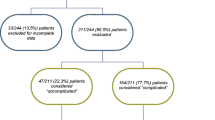Abstract
Introduction
The relevant terminology for stress urinary incontinence (SUI) is affected by the context, namely the clinical assessment (the symptom of SUI elicited on history taking and the sign of SUI observed during examination) or diagnostic investigations (urodynamic stress incontinence). In some cases, SUI may only be observed after the reduction in coexistent prolapse (occult SUI). Classifying SUI often relies on distinguishing between intrinsic sphincter deficiency (ISD), and urethral malposition or hypermobility, although this potentially an over-simplification.
Review
Classification systems have been derived based on clinical assessment and diagnostic testing, notably videourodynamics. Modern developments in imaging technology may allow other techniques such as ultrasound to offer additional basis for future developments in classification. Other urodynamic approaches include urethral pressure profilometry and Valsalva leak point pressure; these may offer indicators of thresholds below which ISD is more likely to explain SUI, but they are not generally accepted in routine practice.
Conclusions
While SUI classification is potentially relevant to treatment selection, evidence for influence on management outcome is limited. Generating a high-quality evidence base for treatment selection on these criteria is problematic, particularly due to the range of confounding factors. In practice, the modern practitioner relies on various tools to form an opinion on some key aspects, using the findings to derive a treatment strategy. Accordingly, there remains a need to confirm how a classification of SUI translates into treatment selection and better outcomes.

Similar content being viewed by others
References
DeLancey JO (1990) Functional anatomy of the female lower urinary tract and pelvic floor. Ciba Found Symp 151:57–69 (discussion 57–76)
DeLancey JO (1994) Structural support of the urethra as it relates to stress urinary incontinence: the hammock hypothesis. Am J Obstet Gynecol 170(6):1713–1720 (discussion 20–3)
Abrams P, Cardozo L, Fall M, Griffiths D, Rosier P, Ulmsten U et al (2002) The standardisation of terminology of lower urinary tract function: report from the Standardisation Sub-committee of the International Continence Society. Neurourol Urodyn 21(2):167–178
Haylen BT, de Ridder D, Freeman RM, Swift SE, Berghmans B, Lee J et al (2010) An International Urogynecological Association (IUGA)/International Continence Society (ICS) joint report on the terminology for female pelvic floor dysfunction. Neurourol Urodyn 29(1):4–20
Horbach NS, Ostergard DR (1994) Predicting intrinsic urethral sphincter dysfunction in women with stress urinary incontinence. Obstet Gynecol 84(2):188–192
Cundiff GW (2004) The pathophysiology of stress urinary incontinence: a historical perspective. Rev Urol 6(Suppl 3):S10–S18
Blaivas JG (1983) Classification of stress urinary incontinence. Neurourol Urodyn 2:103–104
McGuire EJ, Lytton B, Pepe V, Kohorn EI (1976) Stress urinary incontinence. Obstet Gynecol 47(3):255–264
Blaivas JG, Olsson CA (1988) Stress incontinence: classification and surgical approach. J Urol 139(4):727–731
Zhang X, Chen Z, Song X, Yuan X, Cai D, Chen J et al (2013) Application of perineal ultrasound measurement and urodynamic study in the diagnosis and typing of stress urinary incontinence ultrasound and urodynamic study. Urologia 80(3):233–238
Summitt RL Jr, Bent AE, Ostergard DR, Harris TA (1990) Stress incontinence and low urethral closure pressure. Correlation of preoperative urethral hypermobility with successful suburethral sling procedures. J Reprod Med 35(9):877–880
Schierlitz L, Dwyer PL, Rosamilia A, Murray C, Thomas E, De Souza A et al (2012) Three-year follow-up of tension-free vaginal tape compared with transobturator tape in women with stress urinary incontinence and intrinsic sphincter deficiency. Obstet Gynecol 119(2 Pt 1):321–327
Sand PK, Bowen LW, Panganiban R, Ostergard DR (1987) The low pressure urethra as a factor in failed retropubic urethropexy. Obstet Gynecol 69(3 Pt 1):399–402
Costantini E, Lazzeri M, Giannantoni A, Bini V, del Zingaro M, Porena M (2009) Preoperative MUCP and VLPP did not predict long-term (4-year) outcome after transobturator mid-urethral sling. Urol Int 83(4):392–398
Meschia M, Pifarotti P, Buonaguidi A, Gattei U, Spennacchio M (2005) Tension-free vaginal tape (TVT) for treatment of stress urinary incontinence in women with low-pressure urethra. Eur J Obstet Gynecol Reprod Biol 122(1):118–121
Kawasaki A, Wu JM, Amundsen CL, Weidner AC, Judd JP, Balk EM et al (2012) Do urodynamic parameters predict persistent postoperative stress incontinence after midurethral sling? A systematic review. Int Urogynecol J 23(7):813–822
Kapoor DS, Housami F, White P, Swithinbank L, Drake M (2012) Maximum urethral closure pressure in women: normative data and evaluation as a diagnostic test. Int Urogynecol J 23(11):1613–1618
Bump RC, Elser DM, Theofrastous JP, McClish DK (1995) Valsalva leak point pressures in women with genuine stress incontinence: reproducibility, effect of catheter caliber, and correlations with other measures of urethral resistance Continence Program for Women Research Group. Am J Obstet Gynecol 173(2):551–557
Theofrastous JP, Bump RC, Elser DM, Wyman JF, McClish DK (1995) Correlation of urodynamic measures of urethral resistance with clinical measures of incontinence severity in women with pure genuine stress incontinence. The Continence Program for Women Research Group. Am J Obstet Gynecol 173(2):407–412
Crystle CD, Charme LS, Copeland WE (1971) Q-tip test in stress urinary incontinence. Obstet Gynecol 38(2):313–315
Baden WF, Walker TA (1972) Physical diagnosis in the evaluation of vaginal relaxation. Clin Obstet Gynecol 15(4):1055–1069
Blaivas JG (1999) Classifying stress urinary incontinence. Neurourol Urodyn 18(2):71–72
Author information
Authors and Affiliations
Corresponding author
Ethics declarations
Conflict of interest
All contributors made a substantive contribution in the preparation of this manuscript. There were no applicable conflicts of interest.
Ethical standard
Ethical committee review was not required as the manuscript is a review of the published literature.
Rights and permissions
About this article
Cite this article
Kalejaiye, O., Vij, M. & Drake, M.J. Classification of stress urinary incontinence. World J Urol 33, 1215–1220 (2015). https://doi.org/10.1007/s00345-015-1617-1
Received:
Accepted:
Published:
Issue Date:
DOI: https://doi.org/10.1007/s00345-015-1617-1




